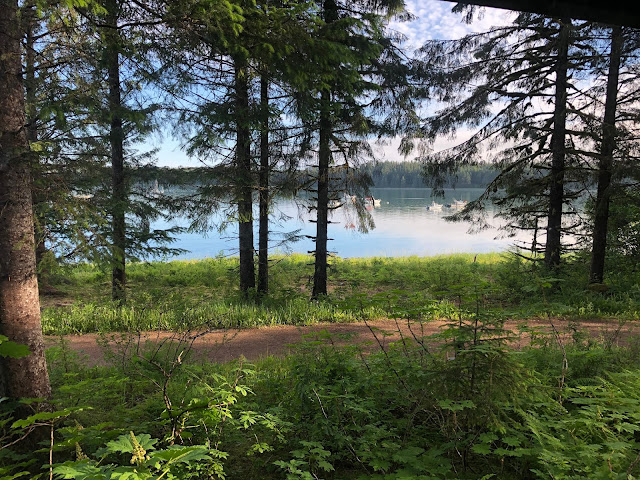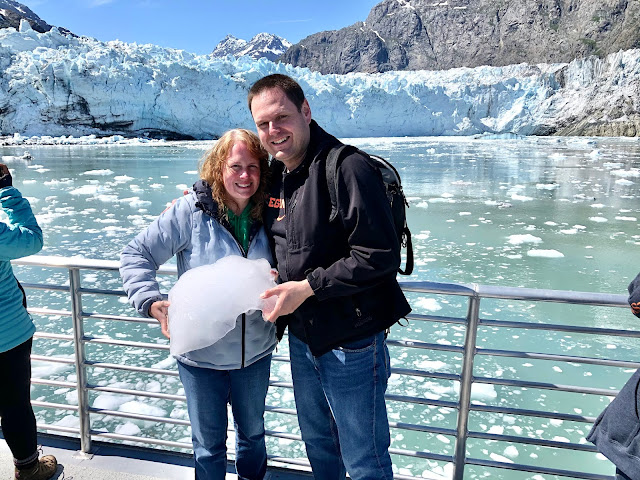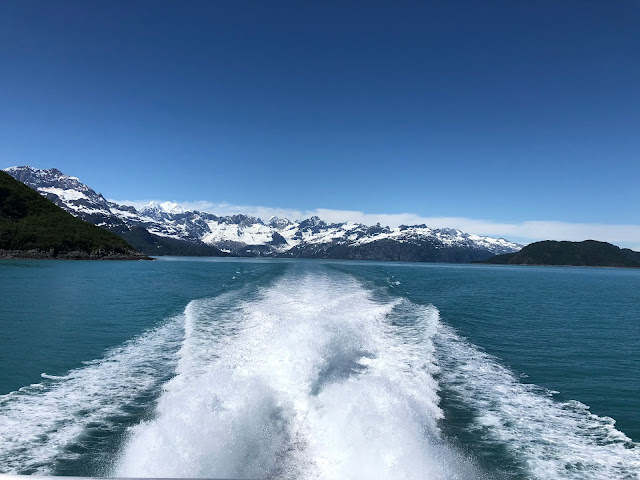Susan and I had an incredible time at Glacier Bay National Park this past week. We arrived in Gustavus on the Alaska State Ferry, and were shuttled to the Glacier Bay Lodge. If you are looking for all the modern amenities, you have come to the wrong place. No cell phone coverage on the property, no televisions in the rooms, and no WIFI in the rooms. There is WIFI in the Lodge, but just enough to send a text or email. However, if you want an opportunity to enjoy nature without distraction, this is the place for you.
This is the view from our room.
The housing, while rustic, was very comfortable and clean. This is the boardwalk connecting the various rooms.
The Lodge was housed in the same building as the Glacier National Park Visitor Center, which was very convenient. There was also a restaurant that provides a very nice breakfast buffet and dinner. There is also a gift store located in the Lodge.
We got up early the next morning to board our vessel, the St. Theodosius. It was very nice, with plenty of indoor seating and viewing areas outside. It was a rare gem of a day in Southeast Alaska, with light winds and temperatures in the 60s.
After the required Coast Guard briefing, we were on our way. It wasn't long before we encountered our first wildlife: Humpback Whales. We would see them frequently throughout the day. In one instance, they were bubble feeding.
Our first stop was the Marble Islands, an important area for bird nesting. Leading up to Marble Islands is a haul-out rock for Sea Lions. We stopped and observed them for a while. They were highly entertaining, as they were noisy and barking at each other.
We then moved on to Marble Island, and observed many birds.
Tufted Puffin
Horned Puffin
Pigeon Guillemot
We continued our journey north into Glacier Bay. At Gloomy Knob, we stopped to observe 10-12 Mountain Goats on a cliff. They were amazing to watch, and we saw one with a baby.
Continuing North, someone spotted two Brown Bear on the beach. It appeared to be a Mother with a larger cub.
Sea Otters are ubiquitous in the Park and are everywhere.
Continuing to journey North, we stopped at the first Glacier: Margerie Glacier. We stopped and listened to it snap, crackle, and pop.
The next stop was the Lamplugh Glacier. It has a very strong blue hue, so much so that it is popularly known as "Lamplugh the Blue."
On the way back, we were able to view the Grand Pacific Glacier. It was fascinating to learn that when the ink was still wet on John Hancock's signature, Glacier Bay was completely covered by a glacier. While the Grand Pacific Glacier once filled the entire Bay, extending into Icy Straits, it has now receded all the way up to the head of the Bay. It is pictured here, looking into British Columbia.
There were icebergs all throughout the Bay, especially near the Glaciers.
We saw Harbor Seals resting on one of the icebergs.
The Fairweather Mountain Range is located within the park, with the highest peak being Mt. Fairweather, standing at 15,325 feet. It is the all white peak in the picture below.
It was now time to head back to the dock, satisfied with a beautiful day in the park of viewing wildlife and glaciers.
After disembarking, we caught a quick picture in front of the National Park Sign.
We loved our time in Glacier Bay National Park, and highly recommend it.


































